Igniting Innovation: The Power of AI Brainstorming for Remote Teams
Remote teams face unique challenges when brainstorming. Effective collaboration and idea generation can be difficult in virtual settings. AI brainstorming tools offer powerful solutions to bridge this gap and unlock creative potential.
This listicle explores 12 of the best AI brainstorming tools available. Discover which tool best suits your remote team's needs. We'll cover key features, pricing, pros, cons, and ideal use cases. This detailed breakdown provides practical insights based on real usage experience.
This list helps you select the best AI for brainstorming. You'll learn how these tools can:
- Generate innovative ideas
- Facilitate seamless collaboration
- Streamline workflows
We'll cover the following tools:
- Bulby
- ChatGPT by OpenAI
- Google Gemini
- Grok AI
- Adobe Firefly
- Notion AI
- Mem AI
- Perplexity AI
- Grammarly
- Supermind Ideator
- AIdeation
- Polymind
1. Bulby
Bulby is an AI-powered brainstorming platform designed for remote teams. It uses structured exercises to guide brainstorming sessions, aiming to maximize creative output and address the challenges of remote collaboration. Bulby's focus on countering cognitive biases and promoting diverse thinking helps teams generate innovative solutions. It's marketed as a tool to smooth the transition from idea generation to actionable insights. This makes it suitable for various uses, from product development to marketing strategies.

One of Bulby's strengths is its structured approach. Teams looking for a guided brainstorming experience will find this beneficial, especially when working remotely. The emphasis on mitigating biases is another plus, potentially leading to more inclusive and well-rounded ideas. For distributed teams struggling with creative roadblocks, Bulby offers a structured path to generate original solutions. If you're looking for the best AI for brainstorming in remote settings, Bulby is definitely worth considering.
Pros and Cons
Pros:
- AI-powered, research-backed exercises
- Designed for remote, hybrid, and distributed teams
- Counters cognitive biases and encourages diverse thinking
- Intuitive platform for smooth idea-to-action transition
- Versatile use cases
Cons:
- Pricing information is not publicly available
- Primarily tailored for remote teams; some features might be less relevant for in-person brainstorming
Implementation and Use
Bulby's focus on remote teams makes it a good fit for organizations operating in distributed or hybrid work environments. Product development teams, marketing teams, and even academic innovation centers could benefit from its structured approach. While it excels in a remote context, in-person teams might find its remote-specific features less relevant.
The lack of publicly available pricing information is a drawback. Potential users will need to contact Bulby directly for a quote. This lack of transparency could be a barrier for some.
Website
2. ChatGPT by OpenAI
ChatGPT is a versatile AI language model capable of generating human-like text. Based on user prompts, it assists brainstorming by providing ideas, answering questions, and generating content across various topics. Its natural language processing capabilities make it easy to interact with, fostering a natural flow of ideas. It's a powerful tool for overcoming writer's block and exploring new creative avenues. Learn more about ChatGPT by OpenAI at https://www.remotesparks.com/ai-brainstorming-tool/.

One of ChatGPT's strengths lies in its ability to generate diverse and creative responses. When exploring new concepts or seeking fresh perspectives, its versatility is invaluable. For content creators, marketers, or anyone looking to refine their messaging, ChatGPT can be a helpful tool. Its conversational style also lends itself well to idea exploration and refinement.
Pros and Cons
Pros:
- Generates diverse and creative responses
- User-friendly interface
- Regular updates and improvements
- Supports multiple languages
- Integrates with various applications via API
Cons:
- May produce inaccurate or nonsensical answers at times
- Limited knowledge of events post-October 2023
Implementation and Use
ChatGPT's user-friendly interface makes it accessible to users of all technical levels. It's particularly helpful for individuals or teams engaged in content creation, marketing, or problem-solving. While its knowledge base has limitations, its ability to generate diverse responses makes it a valuable tool for sparking new ideas. Its API integrations also extend its usability across various platforms.
Website
3. Google Gemini
Google Gemini is an AI assistant integrated within Google's ecosystem. It's designed to help with various tasks, from drafting emails and summarizing documents to generating creative content. This makes it a potential asset for brainstorming, especially within the context of Google Workspace. Learn more about using Google Gemini for brainstorming online at this helpful resource. Its multimodal capabilities (text, image, voice) open up interesting possibilities for idea generation.
One of Gemini's strengths is its seamless integration with Google Workspace. Users can access its features directly within familiar apps like Docs, Sheets, and Gmail. This tight integration can streamline workflows and enhance productivity for teams already reliant on Google's suite. Its context-aware assistance also promises to provide more relevant suggestions and support during brainstorming sessions.
Pros and Cons
Pros:
- Enhances productivity within Google applications
- User-friendly and intuitive interface
- Supports a wide range of tasks, including creative content generation
- Real-time collaboration features
Cons:
- Limited to Google's ecosystem; less useful for teams using other platforms
- Some advanced features may require a paid Google Workspace subscription
Implementation and Use
Gemini is best suited for teams heavily invested in the Google Workspace environment. Product teams can use it to collaboratively draft product specifications in Docs. Marketing teams can leverage it for generating creative copy in Gmail. Its real-time collaboration support facilitates brainstorming sessions, although its effectiveness depends on the team's familiarity with the AI's capabilities.
The potential cost associated with some features is a factor to consider. While basic functionalities might be accessible with free Google accounts, more advanced features might necessitate a subscription. This could limit access for some teams.
Website
https://workspace.google.com/products/gemini
4. Grok AI
Grok AI is an advanced AI assistant designed for complex brainstorming and problem-solving. Its deep reasoning capabilities and real-time web search integration make it a powerful tool for generating innovative solutions. Grok AI is particularly well-suited for technical and scientific brainstorming, supporting coding tasks and offering a customizable interface. It aims to provide up-to-date information and facilitate in-depth exploration of complex topics.
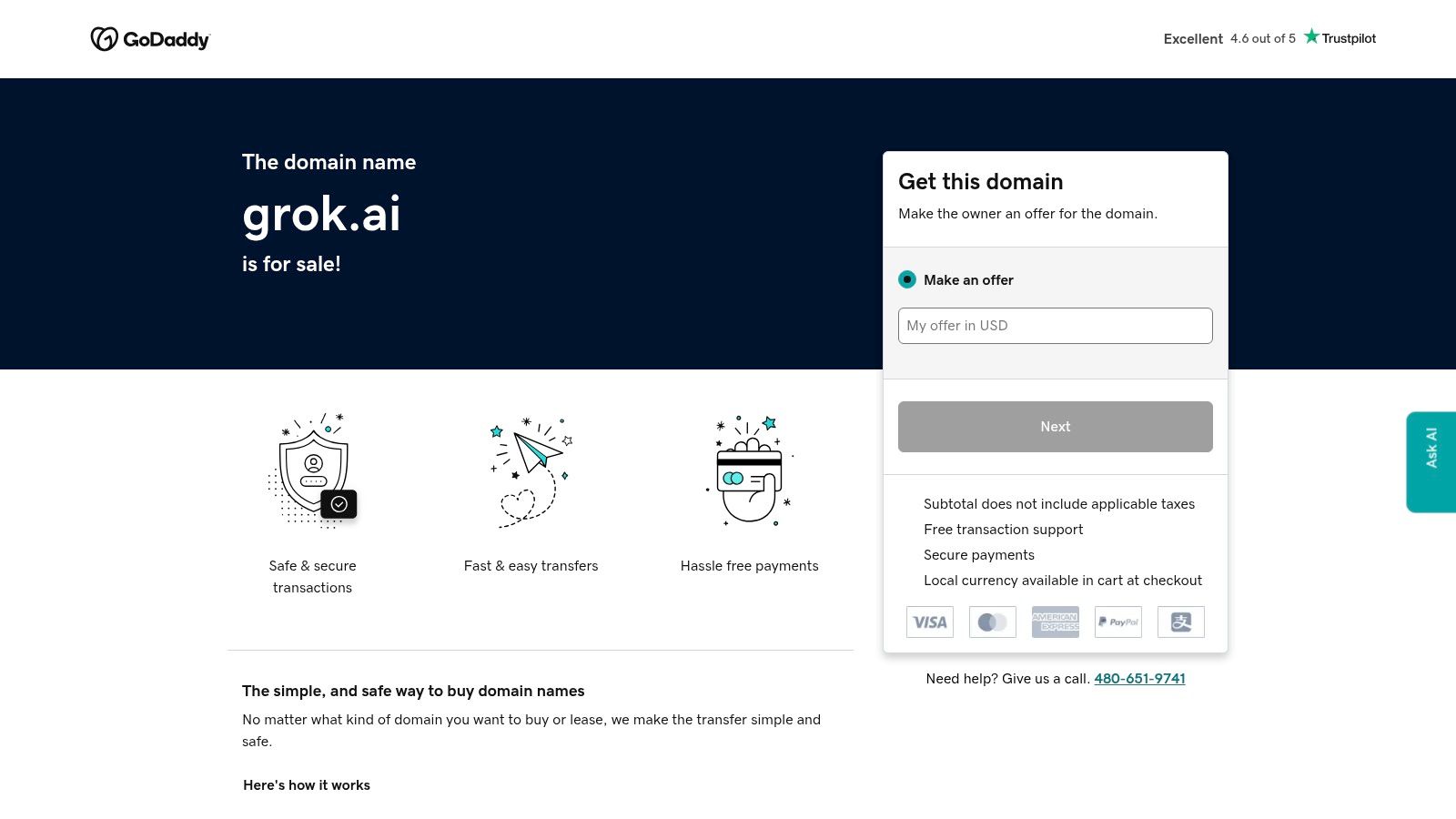
One of Grok AI's key strengths is its ability to handle complex queries. This makes it a valuable asset for teams tackling intricate challenges. The real-time web search ensures access to current information, keeping brainstorming sessions relevant and informed. For teams working in technical fields, the support for coding and technical tasks is a major advantage. If you're seeking the best AI for brainstorming complex, technical problems, Grok AI should be on your radar.
Pros and Cons
Pros:
- Advanced reasoning and logic processing
- Real-time web search integration
- Supports coding and technical tasks
- Customizable user interface
- Multilingual support
Cons:
- User interface may be less intuitive for beginners
- Some features require a subscription
Implementation and Use
Grok AI is ideally suited for technical teams, research groups, and individuals working on complex projects. Its advanced reasoning capabilities can be particularly beneficial in fields like software development, scientific research, and engineering. While the customizable interface offers flexibility, beginners might find it slightly challenging to navigate.
The subscription model for some features could also be a factor in deciding whether Grok AI is the right fit for your team. However, for those who need a powerful AI for complex brainstorming, the investment might be worthwhile.
Website
5. Adobe Firefly
Adobe Firefly is an AI-powered tool integrated into Adobe's Creative Cloud suite. It's designed to assist with creative brainstorming by generating images and designs based on text prompts. Firefly helps users visualize ideas quickly, making it a valuable asset for visual brainstorming and content creation. This focus on visual output distinguishes it from other AI brainstorming tools that primarily deal with text-based ideas.
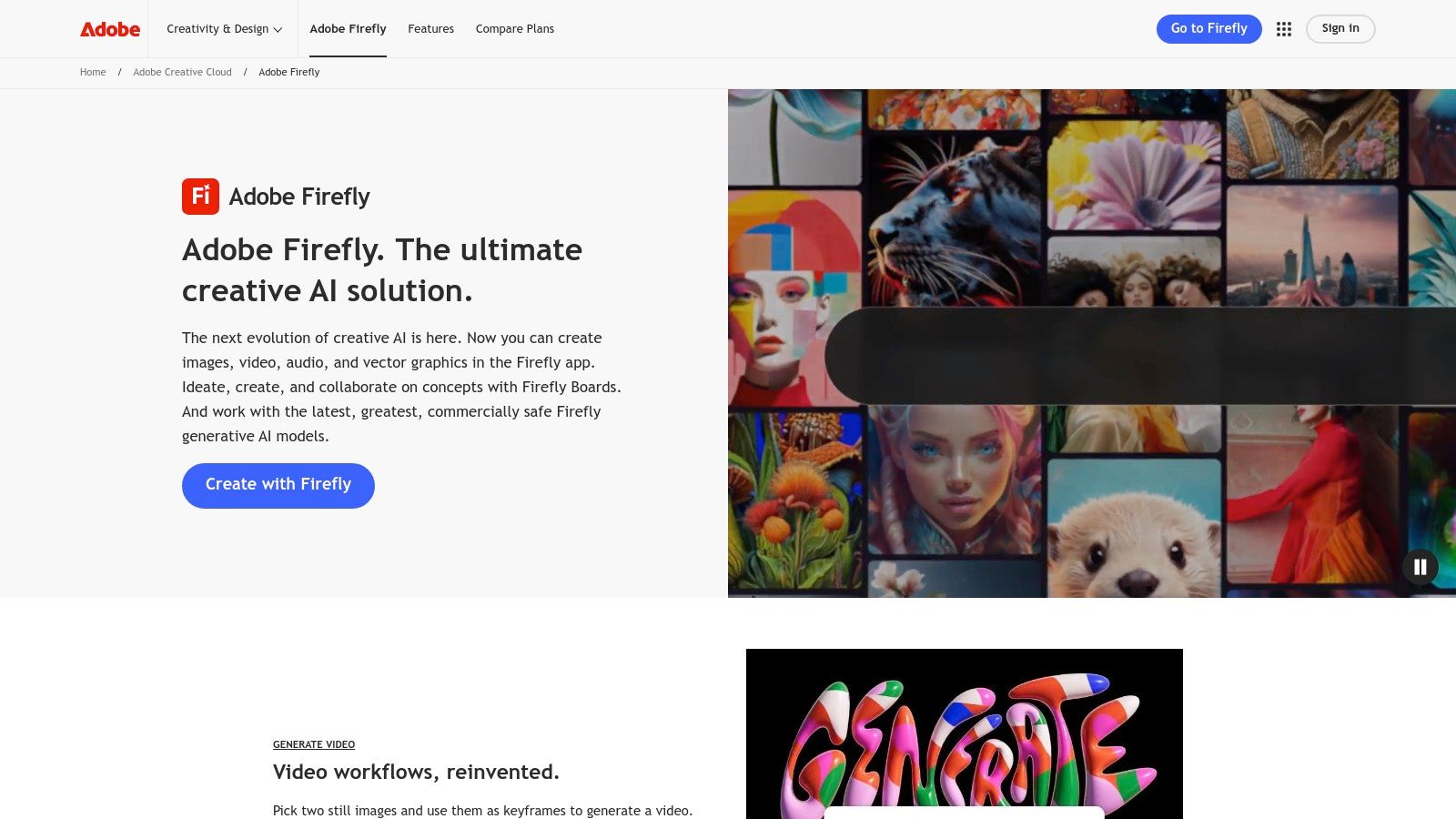
One of Firefly's key strengths is its seamless integration with other Adobe products. This allows for a smooth transition from ideation to creation within the familiar Creative Cloud environment. The user-friendly interface makes it accessible even to those without extensive AI experience. For teams already invested in the Adobe ecosystem, Firefly offers a powerful extension to existing workflows. If you're seeking the best AI for brainstorming visual content, Firefly is a strong contender.
Pros and Cons
Pros:
- Enhances creative workflows
- Seamless integration with Adobe products
- Commercially safe outputs
- User-friendly interface
Cons:
- Requires Adobe Creative Cloud subscription
- Limited to image and design generation
Implementation and Use
Firefly is ideal for creative teams working within the Adobe Creative Cloud ecosystem. Marketing teams, graphic designers, and content creators can leverage its text-to-image capabilities for generating visual assets. Its integration with Photoshop and Illustrator facilitates incorporating generated images directly into ongoing projects.
The requirement of a Creative Cloud subscription limits accessibility for those outside the Adobe ecosystem. While the current focus is on visual content, the potential for future expansion into other creative areas makes Firefly a promising tool in the long run.
Website
https://www.adobe.com/sensei/generative-ai/firefly.html
6. Notion AI
Notion AI supercharges the already popular Notion workspace by adding AI assistance directly into your workflow. It's designed to enhance productivity through AI-powered note-taking, content generation, and organization, making brainstorming sessions more efficient. This makes it a powerful tool for individuals and teams already invested in the Notion ecosystem. Notion AI helps streamline the entire brainstorming process, from initial idea generation to outlining and drafting documents.

Notion AI's biggest strength is its seamless integration with the rest of the Notion platform. If your team already uses Notion for project management and documentation, adding AI capabilities directly within that environment can significantly boost productivity. Its AI writing assistance is especially helpful for quickly generating outlines, meeting agendas, or even first drafts of documents. This makes it a solid option if you're looking for the best AI for brainstorming that fits directly into your existing workflows.
Pros and Cons
Pros:
- Streamlines workflows within Notion
- Enhances productivity and organization
- Supports collaborative brainstorming
- User-friendly interface, consistent with Notion's design
Cons:
- Limited to the Notion ecosystem
- Some advanced AI features require a paid subscription
Implementation and Use
Notion AI is best suited for teams and individuals already using Notion as their primary workspace. It's particularly useful for project teams, content creators, and anyone who frequently takes notes or drafts documents within Notion. Because it is integrated directly into Notion, implementation is straightforward. Users simply need to activate the AI features within their existing Notion workspace.
While a free version offers some AI features, teams looking to maximize the benefits will likely need a paid subscription. Consider the cost versus the value when deciding if Notion AI fits your brainstorming needs.
Website
https://www.notion.so/product/ai
7. Mem AI
Mem AI is more than just a note-taking app; it's an AI-powered workspace designed to streamline your thinking. Its strength lies in connecting your fragmented thoughts, notes, and ideas into a cohesive knowledge base. This makes Mem AI a powerful tool for brainstorming, especially when exploring complex topics or revisiting previous ideas. It's marketed as a "self-organizing workspace," which resonates with its ability to surface relevant information when you need it most.
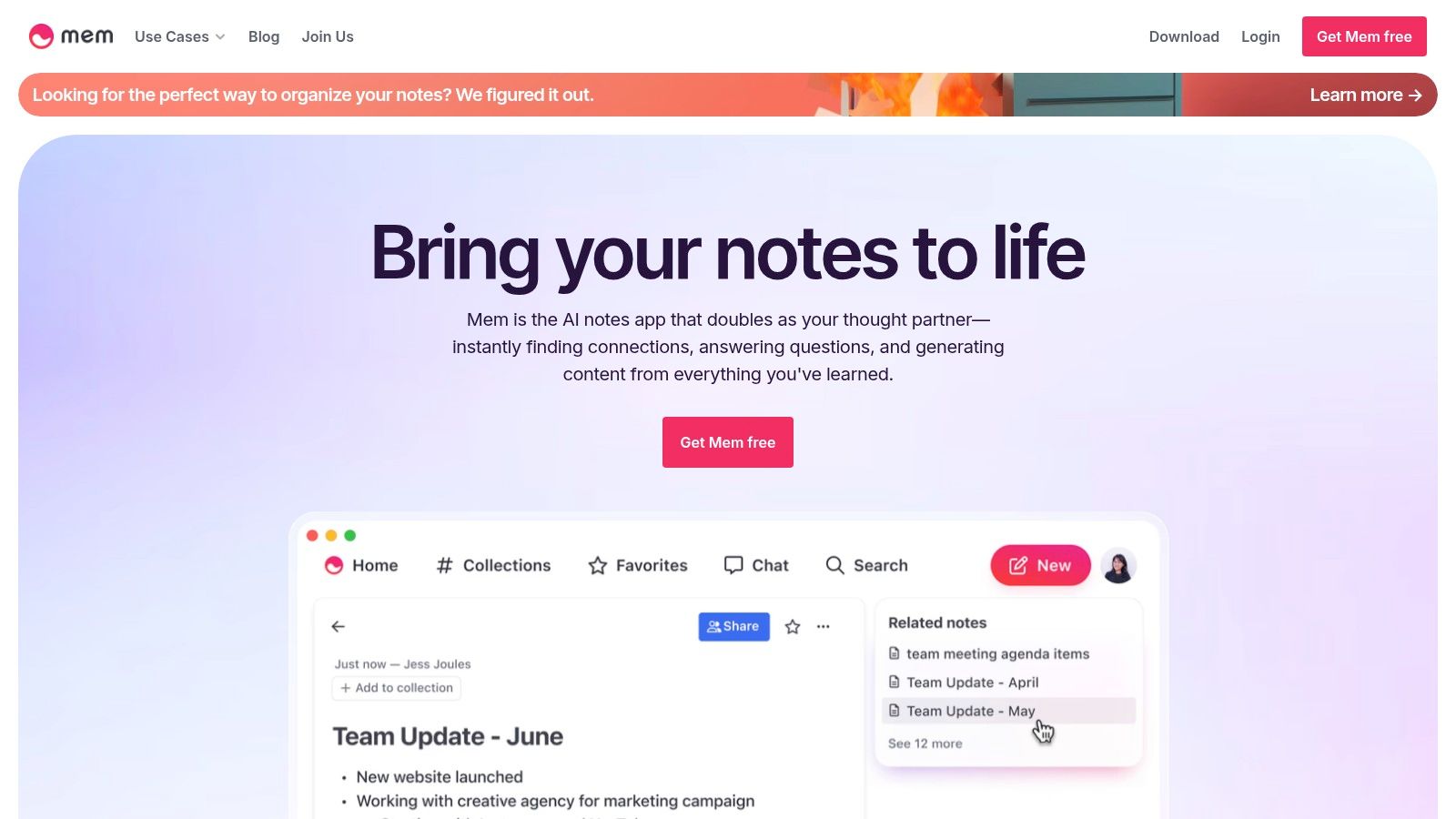
Mem AI excels at helping you quickly capture and connect ideas. The AI-powered search is genuinely helpful in rediscovering past thoughts and sparking new connections. For individuals and teams who value a fluid brainstorming process, Mem AI provides a dynamic environment to capture and explore ideas organically. If you find traditional brainstorming tools too rigid, Mem AI is worth exploring.
Pros and Cons
Pros:
- AI-powered search and retrieval of notes and ideas
- Facilitates collaborative brainstorming and knowledge sharing
- Integrates with existing workflows (calendars, email)
- User-friendly interface encourages quick capture of thoughts
Cons:
- Primarily focused on individual knowledge management; team features are less robust than dedicated brainstorming platforms
- Some advanced features require a paid subscription
Implementation and Use
Mem AI is best suited for individuals and small teams who want a flexible and intuitive brainstorming tool. It integrates seamlessly with existing workflows, which reduces the friction of adopting a new platform. While it offers collaboration features, teams heavily reliant on real-time brainstorming might find dedicated platforms more suitable.
The free version offers substantial functionality, but accessing advanced AI features requires a subscription. Consider the specific needs of your team and workflow when evaluating the pricing plans.
Website
8. Perplexity AI
Perplexity AI is a search-focused chatbot designed to deliver comprehensive and intuitive results. It sources information from across the internet, making it a useful tool for research and brainstorming. Perplexity AI understands natural language and engages in contextual conversations, enhancing the brainstorming process. Its user-friendly interface and multilingual support make it accessible to a broad audience. This tool is best for quickly exploring a new topic or getting a variety of perspectives on a subject.
One of Perplexity AI's strengths is its real-time web search integration. This ensures you're getting the most up-to-date information. Unlike static databases, Perplexity constantly evolves its knowledge base. This is particularly beneficial for rapidly changing fields or trending topics. If you're looking for the best AI for brainstorming fresh ideas backed by current data, Perplexity AI is a valuable resource.
Pros and Cons
Pros:
- Provides up-to-date information
- Enhances research and brainstorming
- User-friendly and intuitive
- Multilingual support
Cons:
- May produce inaccurate or nonsensical answers at times
- Limited to information retrieval tasks; doesn't offer structured brainstorming exercises
Implementation and Use
Perplexity AI is easy to implement as it's readily accessible online. Teams engaged in research, content creation, or preliminary idea exploration can seamlessly integrate it into their workflow. While useful for gathering diverse perspectives, it may not be suitable for tasks requiring in-depth analysis or structured brainstorming exercises. Remember to verify the information provided as the AI's accuracy can vary.
Its limitation to information retrieval means it's best used as a starting point. Use it to spark ideas and gather initial data, then use other tools for deeper dives and structured brainstorming.
Website
9. Grammarly
Grammarly is an AI-powered writing assistant. It helps improve grammar, tone, and clarity. This facilitates effective communication during brainstorming sessions. While not a dedicated brainstorming tool, Grammarly ensures that ideas are articulated clearly and concisely. This minimizes misunderstandings and promotes smoother collaboration, especially in remote settings.
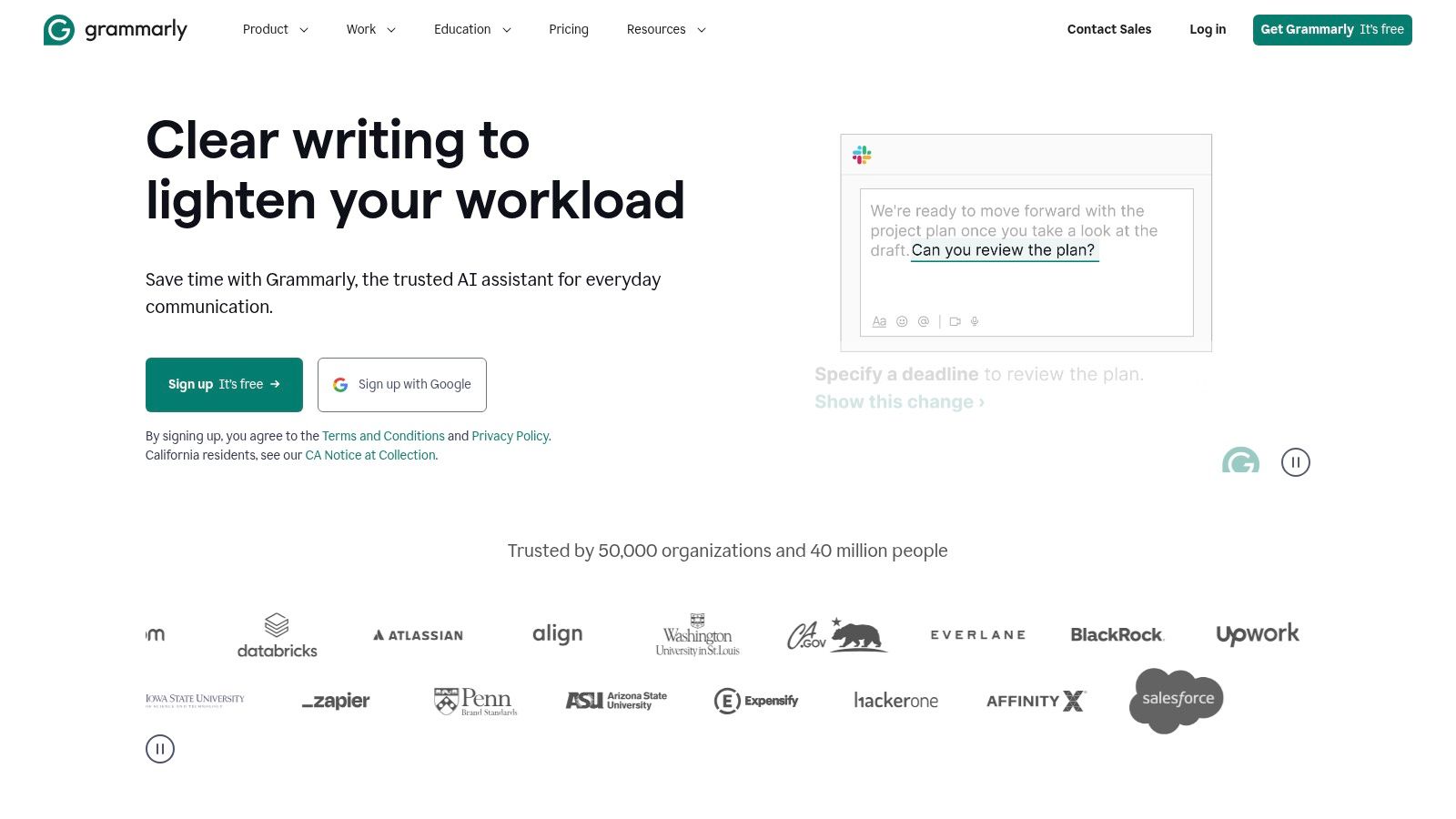
Grammarly's strength lies in its real-time feedback. This is particularly useful when crafting brainstorming documents or communicating ideas within a team. The tone detector helps ensure messages are received as intended, reducing the risk of miscommunication in remote teams. For distributed teams looking to refine their written communication during brainstorming, Grammarly offers a valuable support tool. This makes it a worthwhile addition to a team’s brainstorming toolkit.
Pros and Cons
Pros:
- Enhances writing quality
- Provides real-time feedback
- Supports multiple platforms
- Improves clarity and tone
Cons:
- Some features require a subscription
- May not catch all errors
Implementation and Use
Grammarly integrates seamlessly with various platforms. This includes email clients, document editors, and communication tools. This makes it easy to implement across a team's existing workflow. While the free version offers basic grammar and spell checking, the premium version unlocks advanced features like tone detection and plagiarism checks.
Teams working on collaborative documents, presentations, or even email threads can benefit significantly from Grammarly. It’s especially beneficial for remote teams where clear, concise written communication is crucial for effective brainstorming. Consider the subscription cost against the potential benefits of improved communication and collaboration within your team.
Website
10. Supermind Ideator
Supermind Ideator leverages large language models to enhance creative problem-solving. It generates and organizes ideas, boosting brainstorming sessions. Its user-friendly interface and integration with collaborative tools make it a valuable asset for teams seeking innovative solutions. Supermind Ideator is designed to learn continuously from user interactions, refining its performance over time.

This tool excels at quickly generating a large volume of ideas, making it ideal for teams facing initial brainstorming roadblocks. Its support for various creative problem-solving techniques provides a structured approach to ideation. While primarily focused on idea generation, its integration capabilities allow it to fit into broader workflows. For teams seeking a jumpstart to their brainstorming process, Supermind Ideator is a powerful tool.
Pros and Cons
Pros:
- Enhances creativity and ideation
- Supports various problem-solving techniques
- User-friendly and intuitive interface
Cons:
- Primarily focused on idea generation; may require other tools for complete workflows
- Limited information currently available on pricing and integration options
Implementation and Use
Supermind Ideator is best suited for teams looking to rapidly generate ideas and explore various problem-solving approaches. Its user-friendly design makes it accessible to teams of varying technical expertise. While its focus on idea generation is a strength, teams needing more comprehensive project management features will likely need to integrate it with other tools. The lack of readily available pricing information requires contacting the developers directly.
Website
https://arxiv.org/abs/2311.01937
11. AIdeation
AIdeation is a human-AI collaborative ideation system specifically designed for concept designers. It supports early-stage brainstorming by generating and organizing design concepts. This tool assists with the often challenging initial phase of a design project by providing AI-powered suggestions and helping structure ideas. Learn more about AIdeation techniques for remote teams at RemoteSparks.

AIdeation's strength lies in its ability to enhance creativity and streamline the design process. Its user-friendly interface and flexible search capabilities make it easy to explore and recombine reference images. While it's a powerful tool for designers, its focus makes it less suitable for non-design-related brainstorming. For those seeking the best AI for brainstorming specifically within the design field, AIdeation is a strong contender.
Pros and Cons
Pros:
- Enhances creativity and ideation
- Supports various design workflows
- User-friendly and intuitive interface
Cons:
- Limited to design-related tasks
- May require integration with other tools for full functionality
Implementation and Use
AIdeation is best suited for concept designers working on visual projects. It can be incorporated into various design workflows, helping generate initial ideas and organize visual references. While the user interface is intuitive, full functionality may require integrating AIdeation with other design tools.
Website
https://arxiv.org/abs/2502.14747
12. Polymind
Polymind is a visual diagramming tool leveraging AI agents for prewriting and brainstorming. Its parallel collaboration workflows support multiple users working simultaneously. This focus on visual thinking and collaborative ideation makes it a unique option among AI brainstorming tools. Polymind aims to enhance creativity through its user-friendly interface and integration with collaborative tools. It continuously learns from user interactions, theoretically improving its performance over time.
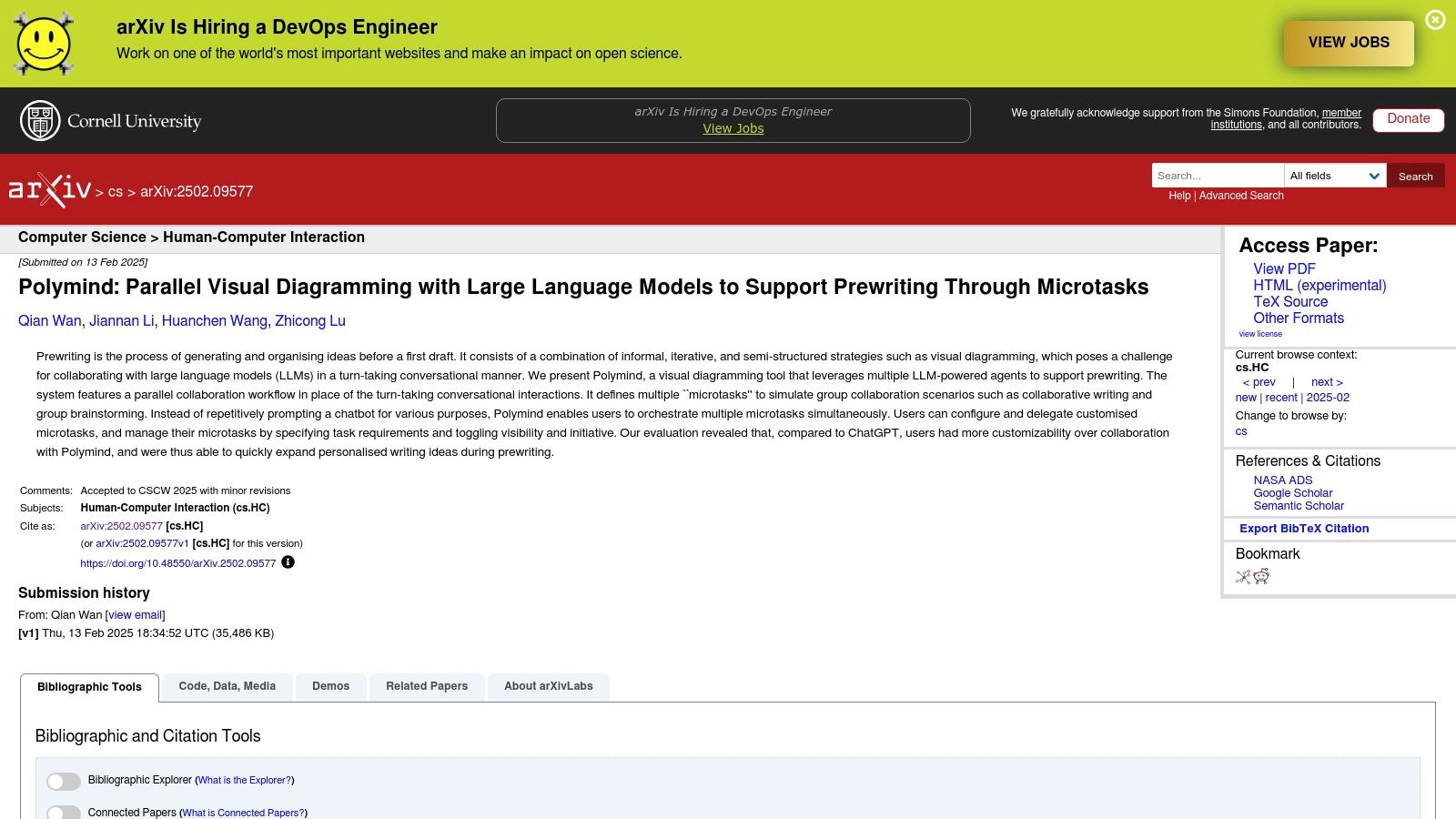
Polymind's strength lies in its visual approach to brainstorming. The AI agents facilitate the process, allowing users to explore ideas in a dynamic and interactive way. This makes it particularly suitable for visual thinkers and teams who prefer diagramming to traditional brainstorming methods. For teams seeking a more visual and collaborative brainstorming experience, Polymind presents an intriguing option among the best AI for brainstorming. Its continuous learning feature promises a potentially evolving and improving user experience.
Pros and Cons
Pros:
- Enhances creativity and ideation
- Supports various brainstorming techniques
- User-friendly and intuitive
Cons:
- Limited to prewriting and brainstorming tasks
- May require integration with other tools for full functionality
Implementation and Use
Polymind is best suited for teams that embrace visual thinking and diagramming. Its collaborative features make it ideal for remote or hybrid teams working on prewriting or brainstorming activities. However, its current focus on these early stages of idea generation might limit its utility for teams looking for a more comprehensive solution.
The potential need for integration with other tools for a complete workflow should also be considered. While the research paper hints at integration capabilities, practical implementation details remain limited.
Website
https://arxiv.org/abs/2502.09577
Top 12 AI Brainstorming Tools Comparison
| Tool | Core Features/Characteristics | User Experience/Quality ★ | Value Proposition 💰 | Target Audience 👥 | Unique Selling Points ✨ |
|---|---|---|---|---|---|
| Bulby 🏆 | AI-guided, structured brainstorming for remote teams | ★★★★★ | Contact for pricing 💰 | Remote/hybrid teams, innovators 👥 | Counters biases, fosters diverse thinking ✨ |
| ChatGPT by OpenAI | Natural language AI, multi-topic idea generation | ★★★★☆ | Freemium options 💰 | General users, content creators 👥 | Versatile, API integration ✨ |
| Google Gemini | Google Workspace integration, multimodal AI | ★★★★☆ | Subscription may apply 💰 | Google ecosystem users 👥 | Real-time collaboration, multimodal support ✨ |
| Grok AI | Advanced reasoning, real-time web search | ★★★★☆ | Subscription may apply 💰 | Technical, scientific users 👥 | Deep reasoning, coding support ✨ |
| Adobe Firefly | Text-to-image AI, Adobe CC integration | ★★★★☆ | Requires Adobe subscription 💰 | Creatives, designers 👥 | Ethical AI image generation, creative workflows ✨ |
| Notion AI | AI note-taking, content generation | ★★★★☆ | Subscription may apply 💰 | Notion users, teams 👥 | Integration with Notion databases ✨ |
| Mem AI | AI-driven note organization and retrieval | ★★★★ | Subscription may apply 💰 | Teams needing note mgmt 👥 | Intelligent search, calendar/email integration ✨ |
| Perplexity AI | Real-time search chatbot, info retrieval | ★★★★ | Free 💰 | Researchers, brainstormers 👥 | Up-to-date info, easy to use ✨ |
| Grammarly | Writing assistant: grammar, tone, clarity | ★★★★☆ | Freemium; Subscription 💰 | Writers, professionals 👥 | Real-time feedback, multi-platform ✨ |
| Supermind Ideator | AI-driven idea generation & problem-solving | ★★★★ | Free/varies 💰 | Creative problem solvers 👥 | LLM-powered ideation techniques ✨ |
| AIdeation | Human-AI co-ideation for design concepts | ★★★★ | Free/varies 💰 | Concept designers 👥 | Design workflow support, image referencing ✨ |
| Polymind | Visual diagramming, AI multi-agent brainstorming | ★★★★ | Free/varies 💰 | Prewriting & brainstorming teams 👥 | Parallel collaboration with AI agents ✨ |
Empowering Remote Teams to Thrive: Choosing the Right AI Brainstorming Partner
Finding the best AI for brainstorming can feel overwhelming with so many options available. This exploration of 12 leading tools provides a solid foundation for your decision-making process. Remember, the ideal tool depends entirely on your remote team's specific needs and workflows. From generating initial ideas to refining existing concepts, AI can revolutionize how your team collaborates and innovates.
Key Takeaways for Remote Teams
Here are some crucial takeaways to consider as you evaluate these AI brainstorming tools:
- Integration is Key: Seamless integration with your existing project management and communication platforms can significantly boost efficiency. Consider tools like Notion AI or Mem AI if integration is a top priority.
- Feature Focus: Different tools excel in different areas. Some, like ChatGPT and Google Gemini, are great for general idea generation. Others, like Supermind Ideator and Polymind, cater to specific brainstorming methodologies.
- Budget Considerations: Pricing models vary widely. Explore free options like ChatGPT's basic version or consider the value proposition of paid tools like Grok AI or Adobe Firefly for their advanced features.
Implementing AI Brainstorming Tools Effectively
Successfully implementing AI brainstorming tools requires more than simply choosing a platform. Here's what to keep in mind:
- Team Training: Provide your team with adequate training on how to use the chosen tool effectively. This will maximize the tool's potential and encourage team-wide adoption.
- Clear Objectives: Define specific goals for each brainstorming session. Having clear objectives helps guide the AI and ensures focused results.
- Iteration and Refinement: AI is a tool, not a replacement for human creativity. Use the AI's output as a starting point and encourage your team to iterate and refine the generated ideas.
Choosing the Perfect AI Brainstorming Partner
Ultimately, the "best" AI brainstorming tool is the one that best fits your team's unique needs. Consider these factors when making your decision:
- Team Size and Structure: Some tools are better suited for smaller teams, while others can handle larger, more complex groups.
- Project Scope: The complexity of your projects will influence which features are most important.
- Long-Term Goals: Consider your long-term innovation strategy and choose a tool that aligns with your future needs.
By carefully considering these factors, you can empower your remote team to unlock its full creative potential and achieve remarkable results. The future of brainstorming is here, and it’s powered by AI. Embrace these powerful tools and transform your virtual brainstorming sessions into dynamic, engaging, and highly productive experiences.
Ready to supercharge your team’s brainstorming sessions? Explore Bulby, a powerful platform designed to enhance collaboration and streamline the brainstorming process for remote teams. Check out Bulby to learn more about how it can help your team generate and refine innovative ideas.

